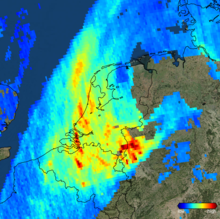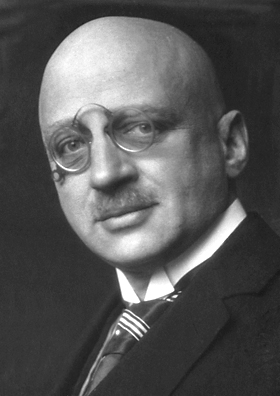
The Haber process, also called the Haber–Bosch process, is the main industrial procedure for the production of ammonia. It converts atmospheric nitrogen (N2) to ammonia (NH3) by a reaction with hydrogen (H2) using finely divided iron metal as a catalyst:
Urea, also called carbamide, is an organic compound with chemical formula CO(NH2)2. This amide has two amino groups joined by a carbonyl functional group. It is thus the simplest amide of carbamic acid.

The nitrogen cycle is the biogeochemical cycle by which nitrogen is converted into multiple chemical forms as it circulates among atmospheric, terrestrial, and marine ecosystems. The conversion of nitrogen can be carried out through both biological and physical processes. Important processes in the nitrogen cycle include fixation, ammonification, nitrification, and denitrification. The majority of Earth's atmosphere (78%) is atmospheric nitrogen, making it the largest source of nitrogen. However, atmospheric nitrogen has limited availability for biological use, leading to a scarcity of usable nitrogen in many types of ecosystems.
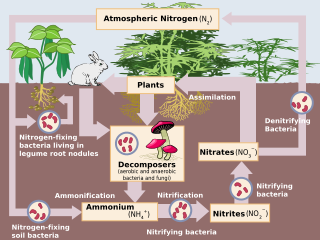
Nitrification is the biological oxidation of ammonia to nitrate via the intermediary nitrite. Nitrification is an important step in the nitrogen cycle in soil. The process of complete nitrification may occur through separate organisms or entirely within one organism, as in comammox bacteria. The transformation of ammonia to nitrite is usually the rate limiting step of nitrification. Nitrification is an aerobic process performed by small groups of autotrophic bacteria and archaea.

Gert-Jan Oplaat is a Dutch politician.

Human impact on the nitrogen cycle is diverse. Agricultural and industrial nitrogen (N) inputs to the environment currently exceed inputs from natural N fixation. As a consequence of anthropogenic inputs, the global nitrogen cycle (Fig. 1) has been significantly altered over the past century. Global atmospheric nitrous oxide (N2O) mole fractions have increased from a pre-industrial value of ~270 nmol/mol to ~319 nmol/mol in 2005. Human activities account for over one-third of N2O emissions, most of which are due to the agricultural sector. This article is intended to give a brief review of the history of anthropogenic N inputs, and reported impacts of nitrogen inputs on selected terrestrial and aquatic ecosystems.
The 1999 Gothenburg Protocol to Abate Acidification, Eutrophication and Ground-level Ozone is a multi-pollutant protocol designed to reduce acidification, eutrophication and ground-level ozone by setting emissions ceilings for sulphur dioxide, nitrogen oxides, volatile organic compounds and ammonia to be met by 2010. As of August 2014, the Protocol had been ratified by 26 parties, which includes 25 states and the European Union.
Nico van Breemen is a Dutch soil scientist. He was a professor of pedogenesis at Wageningen University and Research Centre between 1986 and 2004.

Ammonia pollution is pollution by the chemical ammonia (NH3) – a compound of nitrogen and hydrogen which is a byproduct of agriculture and industry. Common forms include air pollution by the ammonia gas emitted by rotting agricultural slurry and fertilizer factories while natural sources include the burning coal mines of Jharia, the caustic Lake Natron and the guano of seabird colonies. Gaseous ammonia reacts with other pollutants in the air to form fine particles of ammonium salts, which affect human breathing. Ammonia gas can also affect the chemistry of the soil on which it settles and will, for example, degrade the conditions required by the sphagnum moss and heathers of peatland.
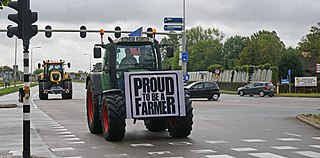
A series of protests by Dutch livestock farmers, characterised by the use of tractors to block roads and occupy public spaces, have been ongoing since 2019. The protests were initially triggered in October 2019 by a proposal in parliament to halve the country's livestock in an attempt to limit agricultural pollution in the Netherlands, but protesting farmers have frequently told media that they are motivated by a perceived lack of respect for their profession by the Dutch populace, media and politicians. The protests combined several action groups and an amalgamation of larger goals, which included less government regulation for farmers, more air time for pro-farmer sentiments, and more policy to punish Shell and Tata Steel for their part in the emission crisis.

The Farmer–Citizen Movement is an agrarian and right-wing populist political party in the Netherlands. It is headquartered in Deventer, Overijssel. The current party leader is founder Caroline van der Plas, who has led it since its creation in 2019.

Derk Geertsz Boswijk is a Dutch politician serving as a member of the House of Representatives since the 2021 general election. A member of the Christian Democratic Appeal (CDA), he previously held a seat in the States of Utrecht from 2015 to 2021 and chaired his party's caucus during the last two of those years.

Brabants Landschap, officially Stichting het Noordbrabants Landschap, is one of the 12 provincial landscape foundations in the Netherlands.
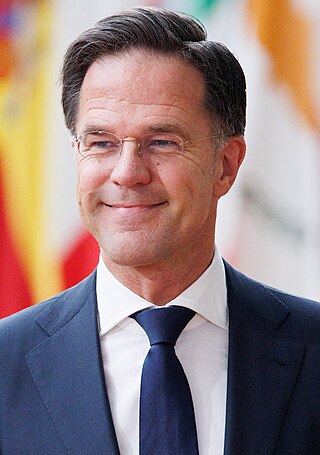
The fourth Rutte cabinet was the cabinet of the Netherlands from 10 January 2022 until 2 July 2024. The cabinet was a continuation of the third Rutte cabinet and was formed by the conservative liberal People's Party for Freedom and Democracy (VVD), the social liberal Democrats 66 (D66) and the Christian democratic Christian Democratic Appeal (CDA) and Christian Union (CU) after the election of 2021. The cabinet fell on 7 July 2023, after failing to reach an agreement on separate treatment of refugees fleeing from war. It continued serving as a demissionary cabinet until the Schoof cabinet was sworn in on 2 July 2024.
An election to the Dutch Senate was held on 30 May 2023. The 75 members of the Senate were elected by members of the provincial councils and electoral colleges elected two months earlier in provincial and electoral college elections.
Ilona Maria Lagas-Meijer is a Dutch politician of the Farmer–Citizen Movement (BBB). She participated in the 2023 Senate election as the Farmer–Citizen Movement's lead candidate, and became the party's parliamentary leader in the Senate. Lagas joined the Farmer–Citizen Movement in 2021 after leaving the People's Party for Freedom and Democracy (VVD), for which she previously served as a municipal councillor and alderwoman.

Eline C. Vedder-Monaster is a Dutch dairy farmer and politician of the Christian Democratic Appeal (CDA). Born in Dordrecht, she studied mechanical engineering and started running a dairy farm in Drenthe with her husband after some years at multinational Unilever.

The Dutch manure crisis is an anticipated surge in the surplus of manure in the Netherlands. It is mainly caused by the phasing out of an exemption to the European Union's Nitrates Directive in the years 2023–2025. Because of this manure derogation, Dutch farmers had been allowed to exceed a limit on organic fertilization, intended to protect water resources from nutrient pollution, since 2006.

Femke Marije Wiersma is a Dutch agricultural lobbyist and politician of the Farmer–Citizen Movement (BBB). She has served as Minister of Agriculture, Fisheries, Food Security and Nature in the Schoof cabinet since July 2024. Previously, she was a member of the Provincial Executive of Friesland.

Greenpeace v State of the Netherlands (2025) is a environmental law case heard by the District Court of The Hague related to the government's adherence to nature protection commitments. It was brought by the Dutch branch of Greenpeace against the State of the Netherlands, arguing that the government's efforts to reduce nitrogen emissions were insufficient to adhere to its goals to protect nitrogen-sensitive nature in Natura 2000 reserves. In January 2025, the court ordered the government to take action to make sure 50% of such areas would no longer exceed the critical load for nitrogen deposition by 2030. The government was ordered to pay €10 million to Greenpeace in case it would fail to comply.

